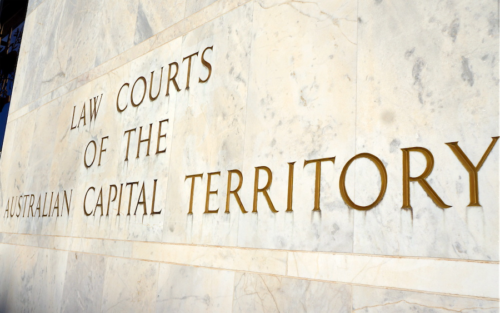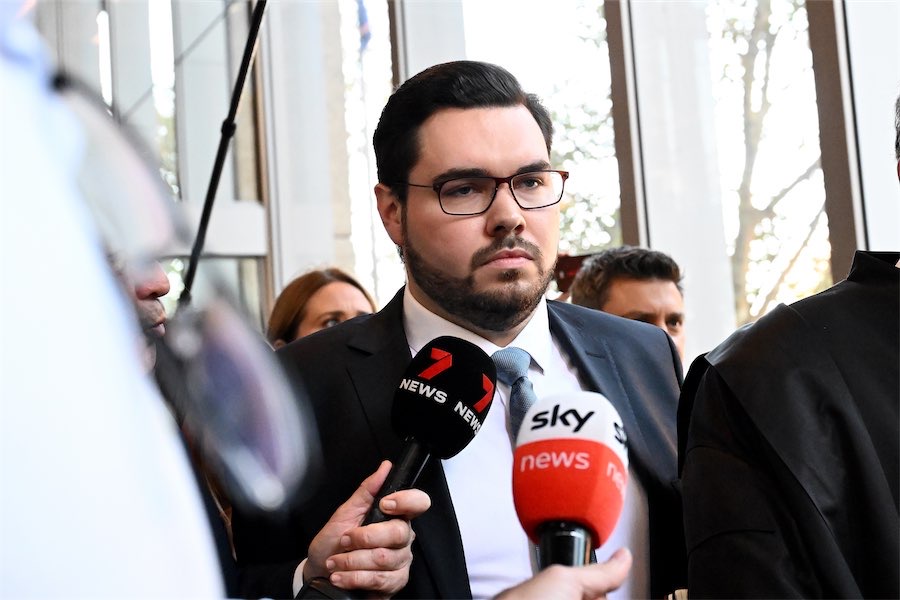
Letter writer DR ANDREW SELTH, says the fight to maintain a local public toilet in Downer suggests the basic needs of the community do not attract the same priority as more expensive projects that command a higher public profile.
THE series of public toilet stories (CN July 29) about the dearth of public toilets in Canberra were a timely reminder that places like shopping centres and public parks lack much-needed community facilities.
 Your correspondents made the excellent point that, not only are such facilities no longer being built by the ACT government, but those that once existed are gradually being lost.
Your correspondents made the excellent point that, not only are such facilities no longer being built by the ACT government, but those that once existed are gradually being lost.
In that regard, the saga of the public toilets at Downer (which were not mentioned in your journal) might be of interest.
For many years, there was a public toilet next to the Downer Village. It was used by local residents, visitors to the village, those playing sport or running their dogs on the nearby ovals, and the occasional itinerant (postmen, taxi drivers and so on).
For a very modest weekly outlay by the ACT government, it satisfied an obvious community need.
For reasons that were never made clear, but seemed to be related to the costs of maintenance, the toilets were closed several years ago, and scheduled to be demolished.
After strong representations from Downer residents, the destruction order was eventually rescinded, but no effort was subsequently made to repair or renovate the toilets, which now stand derelict.
The best that the ACT government could offer, when it received complaints about this situation, was to suggest that people use other facilities nearby, that are not normally open to the public.
It was even suggested (in writing) that visitors to the village, and those using the nearby ovals, use the toilets in the local coffee shop. Unsurprisingly, this prompted a riposte from the cafe’s owners!
Over the past few years, numerous representations on this matter have been made to ACT politicians and officials by the Downer Community Association, local residents and others, but to no avail.
Sadly, it seems that, once again, the most basic needs of the community do not attract the same priority as more expensive projects that command a higher public profile.
(Dr) Andrew Selth, Downer
No loos makes business losers
I LIVE in Garran and there is a lack of public toilets at our local shopping strip. There is a toilet in one small group of shops, but that is only available to “paying” customers of those shops.
The medical centre, which was only completed a few years ago, also has toilets but you have to be a “customer” of one of the tenants to use these toilets. Customers to the remaining retail outlets and the general public have no access to a public toilet.
As there is ample space around the various buildings to accommodate a toilet block, the government needs to provide this basic amenity.
With the technology now available they can be time controlled and automatically secured after the close of business in the strip.
The nearby suburbs of Hughes, Deakin and Mawson have public toilets and this only encourages the public to shop at those locations, which is detrimental to our local retail businesses.
Michael Mowat, Garran
The curse of Canberra
The curse of Canberra is the ACT government and the constraints it places on the ACT Heritage body (“Seven Days”, CN July 29).
My criticism of the proposed destruction of the house at 22 Brockman Street, Narrabundah, and the lack of agency of those who make decisions about heritage is based on my knowledge of this property and the people who commissioned the Derek Wrigley designed house.
I knew Heather and Val Paral, having been fortunate to work with both and having visited their house many times.
Yes, now that both Val and Heather are deceased, the inheritors of 22 Brockman Street have the right to pull the house down and build their version of what fits their needs on the site.
The pity is in doing so they destroy one of the rarest examples of good domestic architectural design that is in sympathy with the Canberra landscape. This house, designed by Val and Heather’s friend Derek Wrigley, was the result of a shared aesthetic and a desire to have the dwelling fit seamlessly into the surroundings so it seems a continuation of the hillside.
Val, who came to Australia as an adult, was captivated by the beauty of the Limestone Plain with its ring of blue hills. I did not know Derek except by reputation as an ANU designer of all things beautiful but as a young person, Canberra born and bred, I was always thrilled to hear Val and Heather talk about their love of Canberra and it is their aesthetic that was so instrumental in my own growing appreciation of what constituted good design.
The house, tucked into Knob Hill, was the outcome of three people’s shared love of the landscape and their understanding that man-made structures that dominate the landscape are a blight on the soul of everyone who calls Canberra home.
The pity is that the right to pull places of historical value down, as happens so often in Canberra, is supported by the gutless wonders in the ACT government and in the bureaucracy who ignore aesthetic and cultural values in favour of economic ones.
Averil Ginn, Sutton
The government deserves the anger
I DEPLORE as hypocritical nonsense the Canberra Indian Myna Action Group’s (CIMAG) latest hysterical attempt to get citizens to kill innocent animals pretending that this will address problems that are caused entirely by humans (“Bill leads a major push against a myna problem”, CN July 29).
This article fails to admit that if there is indeed an “estimated 150,000 of them in the ACT” this is a direct, well-known and inevitable result of the CIMAG’s campaign to get members of the public to kill these animals in incredibly high numbers.
Indian mynas (like foxes, cats, rats, rabbits, pigs, pigeons and, in fact, most other naturalised species) are fast-breeding animals that are essentially impossible to eradicate, other than by sustained fertility control.
It’s the exact opposite of what happens when you kill slow-breeding animals like kangaroos, where the current scale of killing, if sustained, will certainly lead to extinction.
When you kill fast-breeding animals, every single individual killed empties a niche for another, usually younger individual of the same species. Since younger animals are more fertile than older animals, if you maintain a sustained killing program you are maintaining, in perpetuity, a younger population and therefore a larger population.
This is exactly what the CIMAG has been doing with Indian mynas for several decades.
The worst of it is that the government knows this. Scapegoating has been a standard tactic of governments down the ages. Focusing the public’s attention on Indian mynas distracts attention from the single most significant cause of all the environmental (and many of the social) problems currently facing the ACT: endless appropriation of green space and wildlife habitat for urban development.
It incites public anger against a totally innocent party, to keep that anger from falling where it is so richly deserved – on the government itself.
Robyn Soxsmith, via citynews.com.au
They call themselves inclusive!
HAVING to electronically check in everywhere in the ACT ignores the right of residents to keep their old phones or to not have a phone at all. In 2020, businesses had sign in sheets, but these are no longer available to people who cannot digitally check in. Why?
Just leave the sheets at the entrance to your store where people check in near the sanitiser. Not hard really and not a burden, but this has not been considered necessary by the ACT government or the businesses themselves.
Those who make it easy for those without the app to enter their store will attract the business of a whole range of customers while also providing a much needed community service. They will use that business in preference to others that make their lives more difficult, so become dedicated customers.
It has long been obvious that the ACT government makes decisions based on the perspective of a young, fit, well-paid, digitally connected professional, showing no consideration for the rest of the population. They call themselves inclusive, while ignoring and dismissing the needs of a large proportion of ACT residents.
Jennifer Manson, Kingston
Pleased at the professor’s position
I REFER to “Be prepared not surprised when it’s time to die” (CN July 22), an interview by Belinda Strahorn with Prof Imogen Mitchell regarding planning for death and palliative care.
I have worked with Prof Mitchell in my capacity as the CNC L3 charge nurse of the Canberra Hospital ICU during her tenure as medical director.
I was pleased to read that Prof Mitchell has come to such an understanding of the emotional and mental needs of patients facing the end of life, as outlined in the article, as well as their clinical needs.
ICU nurses have been on the front line for decades caring for dying patients. I, like Prof Mitchell, had the privilege of working with and observing these nurses provide an outstanding level of care and compassion.
During my tenure in ICU I advocated for the early involvement of palliative care specialists and services for appropriate ICU patients. I will always be grateful for the insights, compassion and advice on this subject given to me by Pauline Green and medical staff at Clare Holland House. Early intervention by such services, as now confirmed by the research, is vital.
Unfortunately, I was unable to convince Prof Mitchell of the benefits of such an initiative to ICU patients, families and staff. I was very pleased to now read that, as a result of her research, Prof Mitchell has now embraced the need for co-ordinated and compassionate end-of-life care for patients.
I congratulate Prof Mitchell on her study and I am so pleased that the seed I planted many years ago is starting to bear fruit.
Anthony Noakes, Florey
Horrific account of life on Manus
THANKS to Paul Costigan and Jon Stanhope for their articles in your magazine, which reliably provide a few minutes of sanity during these otherwise somewhat chaotic times. They can both be assured of my vote if they ever stand for any public office (again).
Regarding Australia’s long-term and continuing detention of asylum seekers (Jon Stanhope, CN July 29), I recommend Jaivet Ealom’s newly released book “Escape from Manus”.
It is a horrific, informative and gripping account that documents, over a decade, his journey from a brutal regime in Myanmar, to Christmas Island then Manus, often finding similarities between Myanmar and our government’s operations. He, and his fellow detainees, were treated unimaginably inhumanely throughout.
Fortunately Jaivet’s journey has a positive resolution; not thanks to our government but thanks to Canada’s more humane treatment of asylum seekers. The contrast is stark.
Marjorie Crombie, Hall
They don’t look or sound like me
IT’S hard to miss: those speaking, writing and reporting about covid don’t sound, write, or look like me.
In general, those from states and territories giving daily updates appear “white”; those reporting about COVID-19 appear “white”; those reporting from communities-of-colour appear “white.” Such visual and audio disconnects with non-“white” communities exacerbate feelings of separation, leading to current, disparate results!
Our First Australians are sparsely represented in reporting on their communities and continue to endure coronavirus-related inequality.
For each state-territory reporting, why not include updates by representatives from one or more non-“white” communities?
We claim to value multiculturalism, inclusiveness, among immigrants and First Nations’ peoples, but our reporting does not reflect those values.
Perhaps take-up of vaccines and health guidelines would become more equal were there more equal representation!
Judy Bamberger, O’Connor
They’re not asylum seekers
WHO is Jon Stanhope trying to convince in his column “End this ugly political war on asylum seekers” (CN July 29)?
These people are in no way asylum seekers – they are economic migrants. To say they have committed no crime and are innocent victims is incorrect, they arrived here illegally.
Claiming asylum means seeking sanctuary or safe haven and it must be done in the first safe place they arrive at when leaving their homeland. None of these people can claim this. They came to Australia via sometimes several other countries, because it was for a better life. They could have done this by applying through proper channels for immigration status like so many others waiting in the queue – however, they elected to “jump the queue”.
They have been offered the chance to return to their home country but they are refusing.
As an immigrant to Australia nearly 50 years ago, I am well aware what steps have to be taken to prove suitability and these illegal immigrants are no different. To say they are imprisoned is also not correct. They are not in jail, they have the run of the island just like the locals and are being taken care of. They can also leave anytime they like – but not to Australia.
Vi Evans, via email
Political cake and eating it, too
IN “End this ugly political war on asylum seekers” (CN July 29), columnist Jon Stanhope rants about “Australia’s asylum-seeker policies and the manner of their implementation”.
He neglects to add that under the International Refugee Convention, refugees do not have a choice of their country of final settlement.
So Stanhope, undoubtedly knowing full well that no federal government could survive five minutes if it opened the borders to all comers, has his political cake and eats it, too.
He can virtue-signal on the world’s 65 million-plus refugees for all he is worth, knowing full well that he will not be inconvenienced by any consequences.
Ian MacDougall, Farrer
Mental health beats a gold medal
SINCE when has mental health been more important than a gold medal? Always!
It is unfortunate that more people haven’t prioritised their mental, and physical, health over their sport, work, or any performances.
The recent withdrawals of Simone Biles from some Olympic gymnastics events and Naomi Osaka from the Wimbledon tennis championships highlights the pressure top-level sportspeople can face and, yes, some of them can lead fantastic lives travelling the world but not all of them.
It is not a situation I ever faced, but there were always nerves before any games and that was only in front of teammates, school mates and occasionally parents in competitions that did not really matter and have long been forgotten.
There is so much that we have to worry about that perhaps we should all stop and ask for help when needed or even when we just want to talk to someone.
Wise choices, Simone and Naomi.
Dennis Fitzgerald, Box Hill, Victoria
Size does matter, Ian
IAN Wallis (Letters, CN July 29) took me to task for my “Whimsy” column on kangaroos, wallaroos and wallabies – and asked me what my sources for their size were.
Briefly, they were “Kangaroos – Biology of the Largest Marsupials”, TJ Dawson, 1995, and “The Complete Book of Australian Mammals”, R Strahan (Ed), 1983. I accept that there may be a few exceptions to the Macropodidae size rule, but in a short article one has to generalise.
As for Ian’s practical experience with boxing against wallaroos, I trust he did not have an unfair weight advantage and that they enjoyed it as much as he did.
Clive Williams, via email
Who can be trusted?
In a world of spin and confusion, there’s never been a more important time to support independent journalism in Canberra.
If you trust our work online and want to enforce the power of independent voices, I invite you to make a small contribution.
Every dollar of support is invested back into our journalism to help keep citynews.com.au strong and free.
Thank you,
Ian Meikle, editor





Leave a Reply